User:Kirstin Grace Harriger/Notebook/Physics 307L/Excitation Levels of Neon
Steve Koch 03:38, 21 December 2010 (EST):Very good primary lab notebook.
Lab 02: Excitation Levels of Neon
Concepts
- Ionization Potential in Atoms: Electrons can be removed from an atom if the correct amount of energy is supplied in some way. The energy must be more than or equal to the pull of the nucleus. When an electron is removed from the atom, it becomes an ion, and the amount of energy required to remove an electron is called the ionization potential. The ionization potential is different for each electron in an atom. The greater the ionization potential, the less the atom wants to give up the electron. One way to impart energy to an atom in order to remove an electron is through a collision with a free roaming electron. If the electron has enough kinetic energy when it collides with the atom, that energy will cause the atom to release an electron and the collision will be inelastic. If the free electron doesn't have enough kinetic energy, then when it hits the atom the collision will be elastic and the atom will keep all its electrons.
Safety Concerns
- Shock from electrical equipment
- Broken glass from the potentials tube
Equipment
- Hertz Critical Potentials tube filled with neon
- Tube stand: TFL 2501
- Picoamplifier: Tel 2808
- Alarmed Meter: Tel 2021
- Power Supply: Soar DC Power Supply 7403
- Power Supply: Kepco CK60-0.5
- Digital Multimeter: Wavetek 85XT
- 1.5V AA Battery
- BNC Cables
Procedure
We connected them with wires in the following way:
- The ground from the Soar power supply was input into ground, middle of three connectors, on the picoamplifier
- Third of three on picoamplifier connected to negative of the battery.
- Positive of battery connected to positive on kepco power supply.
- Also from positive on kepco power supply:
- Red input on multimeter
- A1 on neon tube stand
- Kepco Negative:
- f3 on stand
- black input on multimeter
- From stand
- F3 to positive on soar
- F4 to C5 on stand
- negative on soar
We turned on our set up and adjusted the input voltage on the Kepco Power Supply to 0. For the first rough scan, we set the voltage to the collector ring on the Soar Power Slupply to 2.1 and we increased the input voltage 1 volt at a time, measuring the current at each increment, from 1 to 25 volts. Then we switched the potential of the collector ring by switching the wires connected to the negative and positive ends of the battery and repeated the rough scan as described. Then we did a fine scan with the collector ring voltage set to 2.1, going from 15 to 22 volts in increments of 0.1 volts. Then to do another rough scan and we set the voltage to the collector ring to 1.8 and we increased the input voltage 1 volt at a time, measuring the current at each increment, from 1 to 25 volts. Then we did a fine scan with the collector ring voltage set to 1.8, going from 15 to 22 volts in increments of 0.1 volts.

This is our set up. From left to right: Picoamplifier connected on top of the
Alarmed Meter, behind that is the Hertz Critical Potentials tube filled with neon
and tube stand, next to them are the two Power Pupplies, on top of the Power Supply farthest right is the Digital Multimeter, in front of the power supplies if the DC battery.
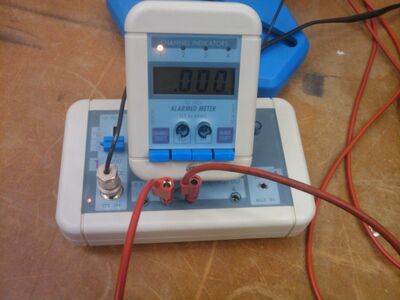
This is a close up of the Picoamplifier connected on top of the Alarmed Meter.

This is a close up of the two Power Supplies and the Digital Multimeter.
Data
Analysis
These graphs were made with MATLAB 7.8. The peaks in the last four graphs indicate where the first ionization potential for neon is in electron volts per atom.
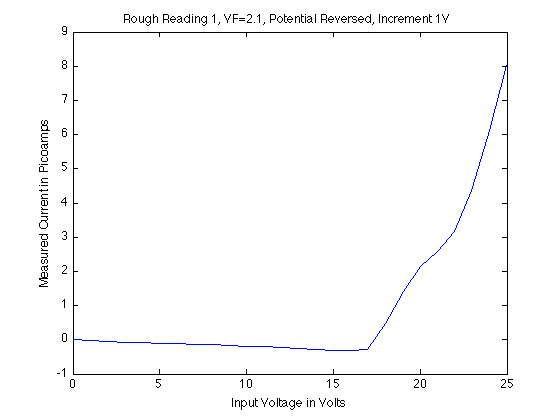
This is our first rough scan.
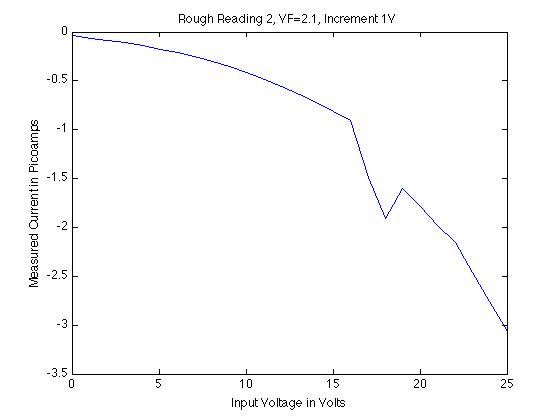
This is our second rough scan, at 2.1 ring collector voltage. The peak is occurs at 18.99 volts when the current is -1.604 picoamps.
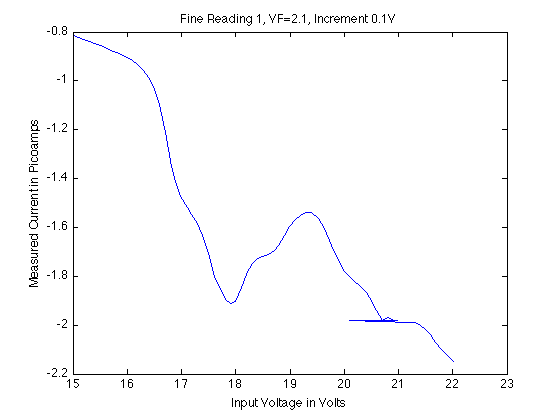
This our first fine scan, at 2.1 ring collector voltage. The peak is 19.4 volts when the current is -1.537 picoamps. There is a fluctuation in values toward the end of the peak between 20 and 21 volts. I think this is due to vibrations from people moving about.
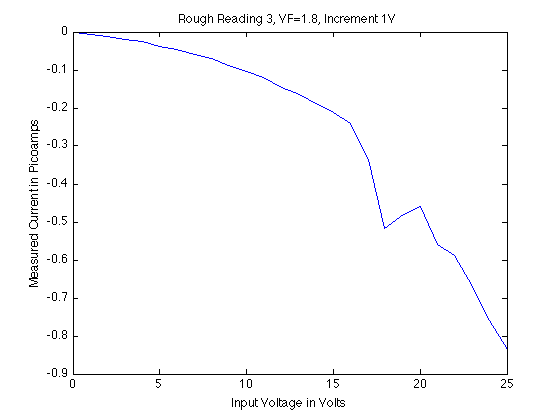
This is our third rough scan, at 1.8 ring collector voltage. This time the peak occurs at 19.99 volts when the current is -0.46 picoamps.
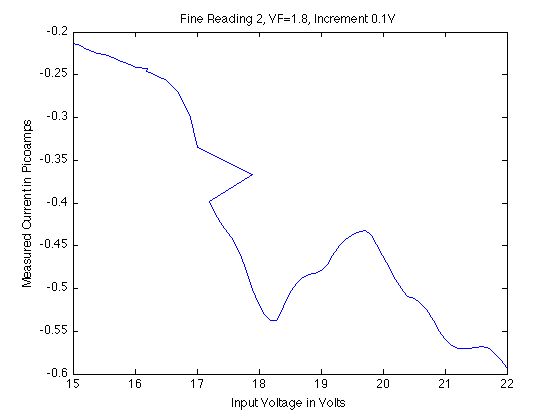
This our second fine scan, at 1.8 ring collector voltage. The peak is at 19.71 volts when the current is at -0.432 picoamps. There is a fluctuation in values before the peak between 17 ad 18 volts. I think this too may be due to vibrations caused by people moving about.
The accepted value from Dr. Gold's Lab Manual for the desired ionization energy of neon is 21.56 electron volts per atom.
The average of the values from our 4 scans was 19.52 +/- 0.01 electron volts per atom.
[math]\displaystyle{ (18.99 + 19.4 + 19.71 +19.99)/4 = 19.5225 }[/math]
This indicates that there is a relative error of 9.45%.
[math]\displaystyle{ (21.56-19.5225)/(21.56) = 9.45 }[/math]%
There is a shift from the known value so there were likely systematic errors in our set up as suggested in Dr. Gold's Lab Manual. There were also errors caused by vibrations to the delicate set up.
Resources
- Prof. Gold's Lab Manual
- Joseph Frye's Neon Excitation Lab
- Alex Benedict's Neon Excitation Lab
- Brian Ritter's Neon Excitation Lab
Collaboration
- My lab partner Brian Josey
- Both Alex Benedict and Joseph Frye helped us immensely during this lab. They got us set up and answered our questions patiently.